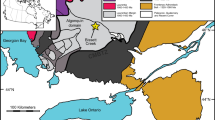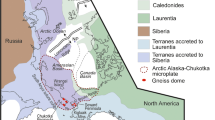Abstract
Flake graphite mineralisation is hosted in the Kuummiut Terrane of the Paleoproterozoic Nagssugtoqidian Orogen, south-east Greenland. Eclogite-facies peak-metamorphic assemblages record temperatures of 640–830 °C and pressures of 22–25 kbar, and are retrogressed in the high-pressure amphibolite-facies during ca. 1870–1820 Ma. Graphite occurs as lenses along cleavage planes in breccia and as garnet-quartz-graphite veins in various metamorphic host rocks in the Tasiilaq area at Auppaluttoq, Kangikajik, and Nuuk-Ilinnera. Graphite contents reach >30 vol% in 0.2–4 × 20 m wide semi-massive mineralisation (Auppaluttoq, Kangikajik). Supergene alteration formed 1- to 2-m-thick and up to a 2.5 × 2.5 km wide loose limonitic gravel containing graphite flakes in places. The flake size ranges from 1 to 6 mm in diameter with an average of ~3 mm. Liberation efficiency is at minimum 60%. Hydrothermal fluids at ~600 °C, transporting carbon as CO2 and CH4, formed the mineralisation commonly hosted by shear zones, which acted as pathways for the mineralising fluids. The hydrothermal alteration assemblage is quartz-biotite-grunerite-edenite-pargasite-K-feldspar-titanite. The δ13C values of graphite, varying from −30 to −18‰ PDB, indicate that the carbon was derived from organic matter most likely from metasedimentary sources. Devolatilisation of marble may have contributed a minor amount of carbon by fluid mixing. Precipitation of graphite involved retrograde hydration reactions, depleting the fluid in H2O and causing graphite saturation. Although the high-grade mineralisation is small, it represents an excellent example of hydrothermal mineralisation in an eclogite-facies terrane during retrograde exhumation.












Similar content being viewed by others
References
Baden K (2016) Paleoproterozic hydrothermal graphite-sulfide ± gold mineralisation from the Tasiilaq area, South-East Greenland. Danmarks og Grønlands Geologiske Undersøgelse, Rapport 1:59
Beyssac O, Rumble D (2014) Graphitic carbon: a ubiquitous, diverse, and useful geomaterial. Elements 10:415–420
Beyssac O, Goffé B, Chopin C, Rouzaud N (2002) Raman spectra of carbonaceous material in metasediments: a new geothermometer. J Metamorph Geol 20(9):859–871
Bondam J (1992) Graphite occurrences in Greenland: a review. Grønlands Geologiske Undersøgelse: Open File Series 92/6
Dawes PR (1989) The Grusgraven locality: border relationships between Precambrian supracrustal rocks and orthogneisses, Kangikajik, South-East Greenland. In: Kalsbeek F (ed.), Geology of the Ammassalik Region, South-East Greenland. Grønlands Geologiske Undersøgelse, Rapport 146: 23–28
Duke EF, Rumble III D (1986) Textural and isotopic variations in graphite from plutonic rocks, South-Central New Hampshire. Contrib Mineral Petrol 93(4):409–419
European Commission (2014) Report on critical raw materials for the EU: report of the Ad hoc Working Group on defining critical raw material, 41 p
Graphite N (2014) About graphite: graphite pricing http://northerngraphite.com/graphite-pricing/
Hall RP, Chadwick B, Escher JC, Vasudev VN (1989) Supracrustal rocks in the Ammassalik region, South-East Greenland. In: F. Kalsbeek (ed.), Geology of the Ammassalik region, South-East Greenland. Grønlands Geologiske Undersøgelse, Rapport 146: 17–22
Horita J (2001) Carbon isotope exchange in the system CO2-CH4 at elevated temperatures. Geochim Cosmochim Acta 65:1907–1919
Jébrak M (1997) Hydrothermal breccias in vein-type ore deposits: a review of mechanisms, morphology and size distribution. Ore Geol Rev 12:111–134
Kalsbeek F, Austrheim H, Bridgewater D, Hansen BT, Pedersen S, Taylor PN (1993) Geochronology of Archean and Proterozoic events in the Ammassalik area, South-East Greenland, and comparisons with the Lewisian of Scotland and the Nagssugtoqidian of West Greenland. Precambrian Res 62:239–270
Kalvig P, Bohse H (1992) Geologisk undersøgelse af grafitforekomster Kangikajik, Tasiilaq Kommune. Grønlands Geologiske Undersøgelse, Report file no. 21317: p. 59
Karhu JA, Holland HD (1996) Carbon isotopes and the rise of atmospheric oxygen. Geology 24:867–870
Kolb J (2014) Structure of the Palaeoproterozoic Nagssugtoqidian Orogen, South-East Greenland: model for tectonic evolution. Precambrian Res 255:809–822
Luque FJ, Pasteris JD, Wopenka B, Rodas M, Barrenechea JF (1998) Natural fluid-deposited graphite: mineralogical characteristics and mechanisms of formation. Am J Sci 298:471–498
Luque FJ, Crespo-Feo E, Barrenechea JF, Ortega L (2012) Carbon isotopes of graphite: implications on fluid history. Geosci Front 3:107–207
Mitchell CJ (1993) Industrial minerals laboratory manual: flake graphite. Technical report WG/92/30, Mineralogy and Petrology Series, British Geological Survey: p. 35
Müller S, Dziggel A, Kolb J (2015) Metamorphic evolution of relict eclogite-facies rocks in the Nagssugtoqidian Orogen, south-east Greenland. Goldsmith 2015, Abstracts: p. 2212
Nutman AP, Kalsbeek F, Friend CRL (2008) The Nagssugtoqidian Orogen in South-East Greenland: evidence for Paleoproterozoic collision and plate assembly. Am J Sci 308:529–572
Pohl WL (2011) Economic geology: principles and practice. Wiley-Blackwell Publishing, first edition: p. 680
Ray JS (2009) Carbon isotopic variations in fluid-deposited graphite: evidence from multicomponent Rayleigh isotopic fractionation. Internat Geol Rev 51:45–57
Rumble D (2014) Hydrothermal graphitic carbon. Elements 10:427–433
Rumble D, Hoering TC (1986) Carbon isotope geochemistry of graphite vein deposits from New Hampshire, U.S.A. Geochim Cosmochim Acta 50:1239–1247
Rumble D, Duke EF, Hoering TC (1986) Hydrothermal graphite in New Hampshire: evidence of carbon mobility during regional metamorphism. Geology 14:452–455
Sanyal P, Acharya BC, Bhattacharya SK, Sarkar A, Agrawal S, Bera MK (2009) Origin of graphite, and temperature of metamorphism in Precambrian Eastern Ghast Mobile Belt, Orissa, India: a carbon isotope approach. J Asian Earth Sci 36:252–260
Scheele N, Hoefs J (1992) Carbon isotope fractionation between calcite, graphite and CO2: an experimental study. Contrib Mineral Petrol 112:35–45
Schidlowski M (2001) Carbon isotopes as biogeochemical recorders of life over 3.8 Ga of Earth history: evolution of a concept. Precambrian Res 106:117–134
Valley JW (1986) Stable isotope geochemistry of metamorphic rocks. In: Valley JW, Taylor HP Jr, O’Neil JR (eds.) Stable isotopes in high temperature processes. Mineralogical Society of America, Rev Mineral 16: 445–489
Wilde SA, Dorsett-Bain HL, Lennon RB (1999) Geological setting and controls on the development of graphite, sillimanite and phosphate mineralization within the Jiamusi Massif: an exotic fragment of Gondwanaland located in north-eastern China? Gondwana Res 2:21–46
Wright AE, Tarney J, Palmer KF, Moorlock BSP, Skinner AC (1973) The geology of the Angmagssalik area, East Greenland and possible relationships with the Lewisian of Scotland. In: Park RG, Tarney J (eds) The early Precambrian of Scotland and related rocks in Greenland. University of Keele, pp 157–177
Yang Q-Y, Santosh M, Wada H (2014) Graphite mineralization in Paleoproterozoic khondalites of the North China Craton: a carbon isotope study. Precambrian Res 255:641–652
Acknowledgements
The Ministry of Mineral Resources (MMR) and GEUS are gratefully acknowledged for financial support of the field and analytical work. This contribution is a product of collaboration between GEUS, the Centre for Exploration Targeting (CET) at the University of Western Australia and the ARC Centre of Excellence for Core to Crust Fluid Systems (CCFS). This is contribution 846 from the CCFS (www.CCFS.mq.edu.au). Marco Fiorentini also acknowledges support from the Australian Research Council through Linkage Project LP120100668 and the Future Fellowship Scheme (FT110100241). Nanna acknowledges Selskabet for Arktisk Forskning og Teknologi (SAFT). We thank Troels F.D. Nielsen for unpublished information about the Nuuk-Ilinnera locality, Kristine Thrane for unpublished dates on diorite dikes in the area, Trygvi Bech Árting for unpublished information on the geochronology of the AIC and discussions and Helene Almind for the technical help during the XRD analyses. This paper is the result of N. Rosing-Schow’s MSc project. We thank the editor Bernd Lehmann and the reviewers including Gilpin Robinson and Karen Kelley for useful comments, which helped improve the manuscript.
Author information
Authors and Affiliations
Corresponding author
Additional information
Editorial handling: K. Kelley
Electronic supplementary material
ESM 1
Sample list with graphitic carbon content; list of carbon isotope values measured in the graphite and marble samples; and grain size distribution curve of two samples on which liberation analysis were done. (DOCX 71 kb)
ESM 2
Photographs of: a garnet-quartz vein (coarse light coloured feature cutting gneiss) in hand specimen and transmitted light photomicrograph. The graphite is growing on the garnet in spherulitic patterns. Grt = garnet; gr = graphite; gru = grunerite; hbl = hornblende; b semi-massive graphite mineralisation at locality B; and c a shear zone within an amphibolite, where graphite is forming anastomosing structures draped around fragments of amphibolite. (GIF 393 kb)
ESM 3
Diagram showing carbon isotope variations through time in carbonates (black) and organic matter (grey shaded area) (modified after Schidlowski 2001). Two marble samples from Charcot Bjerge and one from Nuuk-Ilinnera have been plotted in the diagram. The Nuuk-Ilinnera marble plots within the carbonate isotope spread, whereas the Charcot Bjerge marble is more depleted in δ13C. (GIF 27 kb)
Rights and permissions
About this article
Cite this article
Rosing-Schow, N., Bagas, L., Kolb, J. et al. Hydrothermal flake graphite mineralisation in Paleoproterozoic rocks of south-east Greenland. Miner Deposita 52, 769–789 (2017). https://doi.org/10.1007/s00126-016-0701-9
Received:
Accepted:
Published:
Issue Date:
DOI: https://doi.org/10.1007/s00126-016-0701-9




